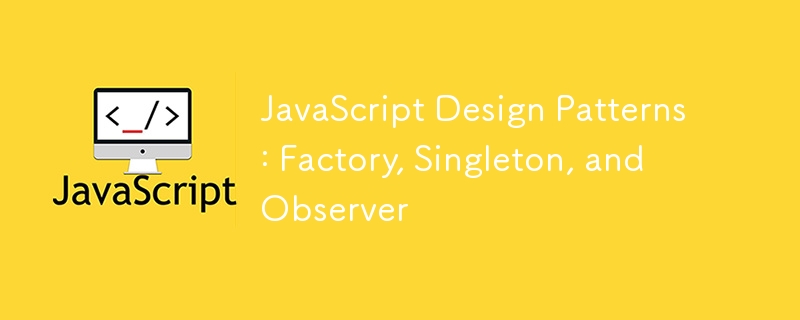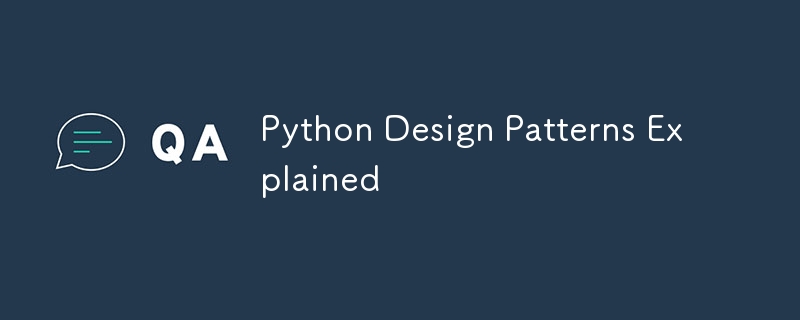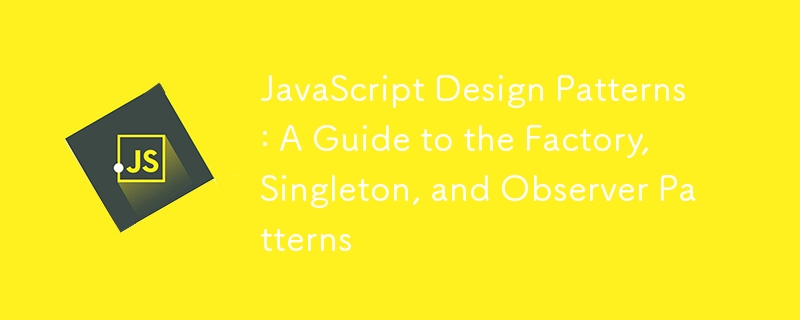Found a total of 10000 related content



Design Patterns in C
Article Introduction:The most commonly used design patterns in C include singleton mode, factory mode, observer mode, and policy mode. Singleton mode ensures that a class has only one instance and provides global access points, which is often used in scenarios such as configuration managers; factory mode encapsulates the object creation process so that the caller does not need to know the specific class name, which is suitable for situations where the object creation logic is complex or changeable; observer mode implements a one-to-many dependency notification mechanism, which is widely used in UI updates or event listening systems; policy mode allows runtime switching algorithms or behaviors, and is suitable for scenarios such as payment systems that require dynamic changes in processing methods. These modes help developers build clearer and easier to maintain code structures by decoupling, hiding implementation details, and improving scalability.
2025-07-25
comment 0
331

C static member variables and functions
Article Introduction:C's static member variables and functions belong to classes rather than objects and are shared among all instances. static member variables are used to save the status information of the class. For example, object counting, which must be defined outside the class, such as counting the number of objects created; static member functions can access static members, suitable for tool methods, singleton mode and other scenarios, but cannot access non-static members; when using it, you need to pay attention to issues such as initialization order, life cycle, thread safety, and access permissions; typical applications include object counting, global configuration management, tool classes, singleton mode and resource cache.
2025-07-09
comment 0
233


Python Metaclasses Deep Dive
Article Introduction:Metaclass is a "template" of a class, used to control how classes are created, suitable for scenarios where framework design or large number of custom class behaviors are performed. It customizes the generation logic of the class by inheriting the type and rewriting the new or init methods. Common uses include automatic registration of subclasses, unified interface constraints, dynamic modification of class attributes, realizing singleton mode and ORM framework design, etc. When using it, you need to pay attention to avoid abuse, high debugging complexity, unintuitive reading order, and compatibility issues. Simple needs can be replaced by decorators.
2025-07-18
comment 0
642

Mastering C# .NET Design Patterns: From Singleton to Dependency Injection
Article Introduction:Design patterns in C#.NET include Singleton patterns and dependency injection. 1.Singleton mode ensures that there is only one instance of the class, which is suitable for scenarios where global access points are required, but attention should be paid to thread safety and abuse issues. 2. Dependency injection improves code flexibility and testability by injecting dependencies. It is often used for constructor injection, but it is necessary to avoid excessive use to increase complexity.
2025-05-09
comment 0
1039

Exploring Common Java Design Patterns with Examples
Article Introduction:The Java design pattern is a reusable solution to common software design problems. 1. The Singleton mode ensures that there is only one instance of a class, which is suitable for database connection pooling or configuration management; 2. The Factory mode decouples object creation, and objects such as payment methods are generated through factory classes; 3. The Observer mode automatically notifies dependent objects, suitable for event-driven systems such as weather updates; 4. The dynamic switching algorithm of Strategy mode such as sorting strategies improves code flexibility. These patterns improve code maintainability and scalability but should avoid overuse.
2025-08-17
comment 0
726

How to implement the singleton pattern in Python?
Article Introduction:There are three main ways to implement Singleton mode in Python: 1. Use a decorator to control the creation and reuse of class instances by defining closure functions. The advantages are that the code is clear and reusable, but the debugging is not intuitive enough; 2. Rewrite the \_\_new\_\_ method to maintain the instances within the class. The advantages are more native and object-oriented, but pay attention to multi-threaded safety issues; 3. Use the natural singleton characteristics of the module to directly create instances in the module and export and use them, which is simple and easy to maintain but poor flexibility. Choose the appropriate method according to actual needs: flexibly control the selection of decorators, object-oriented selection of \_\_new\_\_, and use the modules simply globally.
2025-07-14
comment 0
348

JavaScript Design Patterns for Maintainable Code
Article Introduction:The module mode encapsulates private state through closures, uses IIFE to create independent scopes and exposes limited interfaces, effectively avoiding global pollution and improving testability; 2. The factory mode concentrates object creation logic, returns different types of object instances according to parameters, reducing the client's dependence on specific classes; 3. The observer mode establishes a one-to-many event notification mechanism to decouple publishers and subscribers, and is suitable for event-driven systems; 4. The singleton mode ensures that there is only one instance of a class and provides global access points, which are often used in loggers, configuration management and other scenarios; 5. The decorator mode dynamically adds functions on the basis of not modifying the original object, supports separation of concerns, and can be used for cross-cutting logic such as performance monitoring, permission verification; the design mode should be selected based on specific requirements: encapsulate private numbers
2025-07-27
comment 0
493

JavaScript Design Patterns: Factory, Singleton, and Observer
Article Introduction:Factory mode is used to create objects without exposing construction logic, and generate different types of objects through a unified interface, which is suitable for creating scenarios of multiple similar types of objects; 2. Singleton mode ensures that a class has only one instance and provides global access points, which are often used in scenarios such as configuration management and loggers that require a single state; 3. Observer mode establishes a one-to-many dependency relationship, which automatically notifies all observers when the subject state changes, and is widely used in event systems and data binding. These three modes solve the problems of object creation, instance uniqueness and state response, and use them in combination can improve the modularity, maintainability and scalability of the code.
2025-07-29
comment 0
307


How do I Calculate Age from Date of Birth in PHP and MySQL?
Article Introduction:This article discusses two methods for determining the age of an individual based on their date of birth using PHP and MySQL. The PHP method employs the DateTime class to compute the age difference. The MySQL method utilizes the TIMESTAMPDIFF() funct
2024-10-24
comment 0
399

How do you implement custom session handling in PHP?
Article Introduction:Implementing custom session processing in PHP can be done by implementing the SessionHandlerInterface interface. The specific steps include: 1) Creating a class that implements SessionHandlerInterface, such as CustomSessionHandler; 2) Rewriting methods in the interface (such as open, close, read, write, destroy, gc) to define the life cycle and storage method of session data; 3) Register a custom session processor in a PHP script and start the session. This allows data to be stored in media such as MySQL and Redis to improve performance, security and scalability.
2025-04-24
comment 0
736

A Guide to JavaScript Design Patterns
Article Introduction:The JavaScript design pattern is a reusable solution to common software design problems, helping to write maintainable, extensible, and well-structured code. 1. The module mode is encapsulated through IIFE or ES6 modules to protect private variables and avoid global pollution; 2. The observer mode allows object subscription to the main body changes, which is suitable for event processing and state updates, and is the basis of Redux and other libraries; 3. The factory mode dynamically creates objects at runtime and centrally manages object generation logic; 4. The singleton mode ensures that there is only one instance of a class, which is often used for configuration management but needs to be used with caution to avoid testing difficulties; 5. The decorator mode dynamically adds functions without modifying the original object, and is often used in logs, caches and other scenarios; 6. Revealing the module mode by returning to private
2025-07-29
comment 0
772

How to implement the Observer design pattern in Python?
Article Introduction:Observer mode maintains the observer list through the subject and automatically notifies them when the state changes; 1. Defines the Subject class to manage the addition, removal and notification of observers; 2. The observer implements the update method to receive notifications; 3. Use @property and setter to automatically trigger notify when the state changes; 4. Weak references can be used to avoid memory leaks; 5. It can be simplified into a function or callable object as an observer, making the code more flexible.
2025-08-06
comment 0
962

Python Design Patterns Explained
Article Introduction:The core value of design patterns is to solve the problems of code reuse, maintenance and expansion, rather than show off. 1. Design pattern is a common solution for common problems in object-oriented programming. It is divided into three categories: creation type, structure type, and behavior type; 2. Singleton pattern ensures that there is only one instance of a class, which is suitable for scenarios such as database connections that require global access points, but attention should be paid to thread safety; 3. The factory pattern implements the decoupling of the caller and the specific class through encapsulating object creation logic, which facilitates the use of new types without modifying the use; 4. Observer pattern is used for one-to-many dependency notification, suitable for event-driven systems, such as GUI interaction or framework signaling mechanism. Mastering these common patterns can improve the clarity and maintainability of the code structure. It is recommended to start with the most common patterns.
2025-07-21
comment 0
864

What are design patterns, and how can they be used in PHP?
Article Introduction:Common applications of design patterns in PHP include Singleton, Factory, Observer, and Strategy. They are reusable templates to solve duplication problems, not code that is directly copied. Use scenarios include code duplication, project size expansion, improved testability and reduced dependency. The application steps are: first understand the problem, then select the appropriate mode, keep it simple to implement, and can be reconstructed and optimized later. For example, Factory mode can be used to return different database instances based on configuration, thereby simplifying maintenance.
2025-06-23
comment 0
783

How to implement singleton pattern in C?
Article Introduction:Implementing singleton pattern in C can ensure that there is only one instance of the class through static member variables and static member functions. The specific steps include: 1. Use a private constructor and delete the copy constructor and assignment operator to prevent external direct instantiation. 2. Provide a global access point through the static method getInstance to ensure that only one instance is created. 3. For thread safety, double check lock mode can be used. 4. Use smart pointers such as std::shared_ptr to avoid memory leakage. 5. For high-performance requirements, static local variables can be implemented. It should be noted that singleton pattern can lead to abuse of global state, and it is recommended to use it with caution and consider alternatives.
2025-04-28
comment 0
982

JavaScript Design Patterns: A Guide to the Factory, Singleton, and Observer Patterns
Article Introduction:Factory mode encapsulates object creation logic, making the code easier to maintain and expand, and is suitable for dynamically creating different types of objects, such as UI components or service instances; 2. Singleton mode ensures that a class has only one instance and provides global access points. It is often used in shared resource scenarios such as logging and configuration management, but excessive use should be avoided to prevent testing difficulties; 3. Observer mode defines a one-to-many dependency between objects, and automatically notifies all observers when the subject state changes. It is widely used in event systems, state management and real-time update functions to promote loose coupling between components. These three design patterns solve the problems of object creation, instance control and behavioral communication respectively. The rational use can improve the readability, maintainability and scalability of the code.
2025-08-21
comment 0
513



















